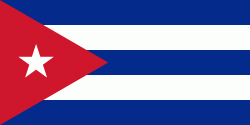Camajuaní
Camajuaní is a municipality and town in the Villa Clara Province of Cuba.
In 1819 was decided the construction of a new port in near Caibarién to replace an old one located in Tesisco. From that moment, settlers established in the surroundings creating a new village. In 1832 blueprints for the new town of Caibarien were presented, and finally in 1841 this city was founded. Consequently, in 1864 an extension of the railway was planned in order to bring the sugar from the Camajuani valley to Caibarien and a new settlement began near the train station. This is the starting point and birth of Camajuaní village.
January 1, 1871 Camajuani was declared a «villa» and on August 1, 1879 the city hall was established. The first mayor of the villa was Hipólito Escobar Martelo.
In the 1907 census Zulueta, which was a barrio at the time was switched from being a part of the municipality of Camajuaní to Remedios.
In 1819 was decided the construction of a new port in near Caibarién to replace an old one located in Tesisco. From that moment, settlers established in the surroundings creating a new village. In 1832 blueprints for the new town of Caibarien were presented, and finally in 1841 this city was founded. Consequently, in 1864 an extension of the railway was planned in order to bring the sugar from the Camajuani valley to Caibarien and a new settlement began near the train station. This is the starting point and birth of Camajuaní village.
January 1, 1871 Camajuani was declared a «villa» and on August 1, 1879 the city hall was established. The first mayor of the villa was Hipólito Escobar Martelo.
In the 1907 census Zulueta, which was a barrio at the time was switched from being a part of the municipality of Camajuaní to Remedios.
Map - Camajuaní
Map
Country - Cuba
 |
 |
| Flag of Cuba | |
The territory that is now Cuba was inhabited by the Ciboney people from the 4th millennium BC with the Guanahatabey and Taíno peoples until Spanish colonization in the 15th century. From the 15th century, it was a colony of Spain, and slavery was abolished in 1886, remaining a Spanish colony until the Spanish–American War of 1898, when Cuba was occupied by the United States and gained independence in 1902. In 1940, Cuba implemented a new constitution, but mounting political unrest culminated in a coup in 1952 and the subsequent dictatorship of Fulgencio Batista, which was later overthrown in January 1959 by the 26th of July Movement during the Cuban Revolution, which afterwards established communist rule under the leadership of Fidel Castro. The country was a point of contention during the Cold War between the Soviet Union and the United States, and a nuclear war nearly broke out during the Cuban Missile Crisis of 1962. Following the collapse of the Soviet Union, Cuba faced a severe economic downturn in the 1990s, known as the Special Period. In 2008, Fidel Castro resigned after 49 years of leadership of Cuba and was replaced by his brother Raúl Castro.
Currency / Language
| ISO | Currency | Symbol | Significant figures |
|---|---|---|---|
| CUC | Cuban convertible peso | $ | 2 |
| CUP | Cuban peso | $ | 2 |
| ISO | Language |
|---|---|
| ES | Spanish language |















